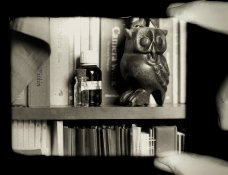Herzeleid
Member
Of course this is not staining, but the color of the dye blocks some UV light like the color from stain. This is more like a color filter.

Update on my progress.
This time I meticulously monitored the temperatures of silver nitrate and salted gelatin before mixing and temperature during ripening, digestion. In hopes of eliminating the possibility of dead grains.
As Ron Mowrey suggested I initially used D76 1+1 (ID-11 to be precise) for testing the development and exposure.
I coated some 10x10" plates with 20ml and some with 25ml to compare densities. 25ml was easier to coat such large area.
I have reduced the amount of chrome alum to a quarter of its recommended value. No subbing on glass.
Exposed the plates as ISO 3 with blue rich CFL bulbs.
I started seeing developer action on plate within a minute, glass cleared at most in 3 mins during fixing.
I haven't observed any frilling, so I believe the amount of chrome alum is still good enough.
Later I switched to home made Rodinal 1+25 as developer and no pepper grain, tested 3 plates with PaRodinal. Looks dense enough, though I haven't measured it.
View attachment 198235
So it seems for this particular photo-grade gelatin chrome alum was really getting in the way.
Thanks everyone for their valuable input.
beautiful image !
im glad you figured it out,
the image is a real treat to look at !
is this a glass positive ?
john
I just keep track of total volume before and after washing, and then add back gelatin to get to the original percentage.
As far as how much to coat per plate: Hard-earned experience. Use about 0.25ml per square inch to get a good coating. Trying to set the silver concentration with coating thickness is the wrong approach because tge thickness has a far greater impact on the coating quality. Too much emulsion and you’ll waste emulsion and it’ll take forever to fix. Too little and you won’t get a good coating.
Jason is right. Experience, and then consistency is the key to repeatable nice plates. Some recipes call for "make-up" gelatin; others don't. Find a good recipe and then trust it. My KBr recipe is carefully calibrated so that adding gelatin after washing is not necessary. Squeezing the bag of noodles brings the gelatin-to-water ratio to the right place. If you feel it helps, you can follow up the squeezing with wringing the bag gently in a folded bath towel. Again, consistency is key. Since there are so few steps in a basic negative recipe, consistency isn't hard to manage. If you feel like your coating is too thick, raise the coating temperature just a bit. If it's too thin, cool it a bit. Don't forget to take room temperature into account. Keep a notebook. Once you know what works, stick with it. It does seem like you're having great luck!

 )
)I weigh before and after washing and add the amount of gelatin needed for the correct concentration. I try to aim for a middle weight of 8% by weight, or 8 g of dry gelatin, in 92 g of emulsion for a total of 100g.
PE
8% will suspend larger grain (a lesson learned the hard way) and the viscocity is different. I run 5-6% but would go higher if I changed my coating methods.
Ohh, the cause of swirly patterns was that?
I use 8% for hand coatings because it is a happy middle ground. Not to thick and not too thin. Just right.
If you coat using machine or doctor blade, you have even more latitude due to the ability to vary gap width and coating rate.
PE
Give careful consideration to which variables you choose to manipulate. If you add extra gelatin to watery noodles, you will significantly change the silver ratio of the emulsion. This can be consequential. Perhaps a better idea to try (at least first) is to wring a bag that is heavier than usual in a clean bath towel. A couple of times, if necessary. If that doesn't bring your water weight to within your normal parameters, something else is going on. Dumping in extra gelatin (in a recipe that doesn't call for it) will not likely be a solution. (2 cents, and many years experience) d
| Photrio.com contains affiliate links to products. We may receive a commission for purchases made through these links. To read our full affiliate disclosure statement please click Here. |
PHOTRIO PARTNERS EQUALLY FUNDING OUR COMMUNITY:  |


